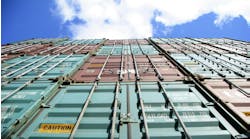Reverse logistics is a poorly-understood concept in business, and what is even more poorly understood is the role that technology has in facilitating this important process.
Reverse logistics gets its name because it is the opposite of forward logistics. As a business sells products, they can have the products moved from a warehouse directly to the consumer or to distributors. Reverse logistics, as the name implies, is exactly the opposite. It is a nuanced and complex process that presents a manufacturer with a number of problems that fortunately can be solved by the correct application of business software. These problems include:
Problem 1: Tracking Value – One major challenge is determining and tracking the value of the unit. So let’s think of an easy example – a registration system for a flexographic press. Let’s say a technician is dispatched to replace a system at a customer site.
A brand new system might have a value of $5,000. In forward logistics, cost is a simple number. But what happens when the engineer in the field swaps out the good assembly for the defective one? Now, he is supposed to send the defective one back so that it can be repaired. But the defective system doesn’t have full value. It is not worth $5,000, because it doesn’t work. But it is not worth $0 either because the company might be able to change one little sub-component and make it a useful unit for the repair pool.
Software that handles reverse logistics has to take into account the useable status of the item and track the unit on a basis that is valued at less than full cost but more than zero cost. And so that is just one small example of some of the interesting characteristics of a reverse logistics operation that really isn’t the same as forward logistics.
Problem 2: Tracking warranty and routing status – Things get even more complex when a reverse logistics value chain includes third party repair by an OEM or items under warranty.
Sometimes a part may be under warranty from your supplier that is either in force for a longer or shorter period than the one that you yourself offer. Reverse logistics software is able to track those secondary warranties back to the OEM and generate the appropriate claims for warranty service provided. Using the right software, a company involved in reverse logistics can claim millions of dollars in warranty reimbursements back from their supplier that they weren’t able to track otherwise just by being able to say units that were acquired on a particular day are still within the two year warranty. Here is the evidence. Please make an adjustment in financial consideration.
Reverse logistics software can also handle automated routing of items within a repair facility and to other repair facilities, whether they are third Party providers or not.
Dealers, Contractors, Efficient Repairs and the Bottom Line
Problem 3: Handling dealers and contractors – Complexity increases further when it extends beyond a company’s own service organizations to third parties like contractors, subcontractors or distributors that participate in aftermarket support.
As the distributor buys a particular subassembly, they might build it into their own product assembly, or they might sell it directly to their customers. They might send boxes of 10 of these repairable components back to the manufacturer’s repair facility. Software for reverse logistics needs to take into account the nature and quality of that business relationship. When there is a good business relationship with that outside entity, rules can be set up in the software to advance replacement parts to them when they simply notify us that they are sending the repairable units through a return material authorization.
When the replacement parts are advanced to the dealer or contractor, the system still needs to keep track of whether they did in fact send their 10 defective units back. So it is equally important to create another business rule that specifies that the distributor gets, for instance, up to 10 days to send the defective subassemblies back. And then when that date is at risk of passing, send a notification to the right individuals to ensure the parts come back into inventory.
Keeping track of this level of reverse logistics interaction between trading parties on a manual basis or even in some computerized systems not specifically designed for the task is impossible. The ability to avoid losing track of products in a reverse logistics value chain, even when they are out at a third party, is a very important financial consideration and must be a consideration in selecting software to handle these functions.
Problem 4: Driving efficiency in repair processes – Software used for reverse logistics can also streamline work in the depot repair environment through the use of visualization – videos or drawings that demonstrate to the repair technician how the work is to be performed.
Software can provide a short video or tutorial to the engineer on the bench. We can illustrate how a given component is disassembled, how you would do a preventive maintenance cleaning, or make a required adjustment. So we are able to take someone who is perhaps not as skilled on a product and let them, through the use of these visualization tools, get a quick tutorial so that they can actually work on products even as they are getting over their learning curve.
Reverse logistics software can include video tutorials for bench techs, compressing the learning curve for specific repair processes.
When software accommodates the reverse logistics process to this extent, a company can get much more productivity out of their engineers then they could before.
The Bottom Line
Business requirements for reverse logistics are complex, and can change as relationships with customers, distributors and contractors shift over time. Apart from the problems mentioned above, software ought to be able to solve challenges related to collecting quality information across the reverse logistics process, tracking and managing re-repairs and repair of sub-components independent of the main assembly. But with the right technology, all of these challenges can be surmounted so you can concentrate on profitably serving your customer.
Larry Laux is the senior vice president at IFS North America, where he is responsible for growing the company’s footprint in the field service management software industry. He came to IFS as the CEO of Metrix, the leading field service management software vendor IFS acquired in 2012.




